1.25: Asian Popular Music- Special Focus on Japan and India
- Page ID
- 168938
Asia includes highly diverse sets of cultures including China, India, Japan, southeast Asia, and the majority of Russia. Each of these regions have unique traditional music that impacts the sound of their popular music. Popular music from each region contains certain elements, more or less, of western pop music. However, in many cultures (specifically Japan) they have developed certain western music industry practices beyond most western popular music.
Japan: Enka
Enka was the first type of popular music in Japan to gain widespread popularity. The music borrows elements from western popular music, infusing those elements into traditional Japanese music. It often uses the pentatonic scale, a traditional source for Japanese folk melodies, for melodic material. Enka is now looked at as a “traditional” genre of popular music, somewhat similar to country music in that it was the first step from traditional folk music into the popular music world.
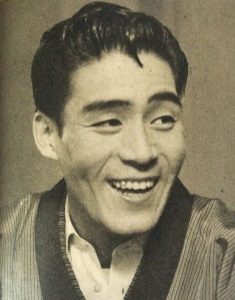
Hachiro Kasuga (1924-1991) is often called the “first enka singer” and in his music the influence of American jazz and country music is often heard alongside traditional Japanese folk music. Hibari Misora (1924-1991) was an actress and singer of Enka. In her music one can hear the influence of classical, jazz and country music alongside Japanese traditional music. In the recordings of Enka in Ch. 25 Listening Examples, one can hear traditional Japanese music in the vocal and instrumental melodies, Western instruments such as acoustic guitar and orchestral strings and wind instruments, and Western style chord progressions.
While Enka was popular through the 1970’s, it began to decline in the 1980’s and by the 1990’s Japanese youths were becoming less and less interested in traditional themes and instruments (their parent’s music) and more interested in J-Pop, a much more western influenced sound. The 31 year old American enka singer Jero, who is of African-American and Japanese descent, has started a slight resurgence of enka, though it’s largest demographic in the US is older Japanese-Americans.
Listening Examples 25.1
Hachiro Kasuga:“別れの一本杉” – translated literally as “Farewell One Cedar”
Hibari Misori: “Shina No Yoru” (Early Japanese popular music called Enka)
J-Pop: Happy End
J-Pop is a strand of Japanese popular music that more closely resembles western popular music and has its origins in the music of the Beatles and other pop groups from the 1960s. The first J-Pop bands emerged in the late 1960’s and early 1970’s though the term wasn’t coined until the 1990’s. J-Pop stands out from other genres of Japanese pop music in that it uses a pronunciation that is much closer to English. Happy End is regarded as one of the most important and pioneering of Japanese rock bands. Listening to the following example, the western listener probably cannot discern any notable differences between the music of Happy End and western groups other than the fact that it is sung in Japanese. The instrumentation, style, form, and melodic phrases are all western in origin and contain little Japanese influence.
Exercise 1
Please read the article, “Some Aspects of Japanese Popular Music” by Kitagawa Junko, linked as it explains some of the musical characteristics that were adopted by Japanese popular musicians and gives a brief, easy to read introduction on the development of J-Pop.
Visual Kei
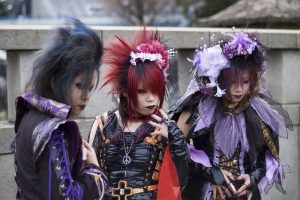
Visual Kei is a Japanese musical movement that uses elaborate costumes, makeup, and hairstyles occasionally forming an androgynous image. Early on, the visual aspects were combined with hard rock music styles and ballads very similar to glam-rock. Presently, the term ‘visual kei’ can be applied to a variety of genres where the performers wear elaborate costumes and makeup. The music usually resembles western popular music styles.
The group X-Japan (formed 1982) are credited as the pioneers of the genre. They are generally considered related to the glam-rock genre with regards to their appearance, but were musically more related to bands such as Metallica. Newer visual-kei groups are sometimes more pop-oriented or heavy metal oriented. These new groups often are themed visually in certain ways, sometimes dark or “Gothic”, sometimes superheros or videogame characters, and sometimes androgynous in the way David Bowie appeared in the 1970s.
Listening Examples 25.2
Happy End:“Ayakashi No Doubuten” (“Ayaka City Zoo”, 1970; some of the earliest J-Pop)
Visual Kei:
- Psycho le Cemu: “Roman Hikou”
- Psycho le Cemu: “Ai no uta”
Blending Tradition with Modern Popular Music: Yoshida Brothers
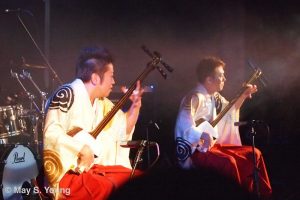
The Yoshida Brothers are a duo of shamisen players that add elements of rock such as riffs, synthesizers, and drums into traditional Japanese folk-styled music. Both brothers have studied traditional Shamisen since they were 5 years old. Though the music is performed on traditional instruments based on traditional scales, it is easy to draw parallels to modern pop styles such as rock. Try to imagine the shamisen lines (in the Ch. 25 listening example) played through distorted electric guitars, and perhaps the parallels will be audible to you. One important similarity between traditional Japanese folk and rock is the pentatonic scale, a building block of both musical styles. (See the video example of Delta Blues Guitar Techniques” from Day 2: The Blues if you need a reminder.)
Listening Examples 25.3
Yoshida Brothers: “Kodo”
Modern Pop Trends: AKB48
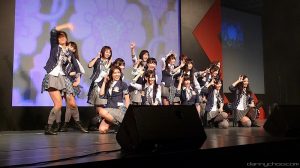
AKB48 is an all-female Japanese pop group that has become so popular it is now regarded as a “social phenomenon”. The group made over 200 million dollars in record sales in 2011 alone. The most striking feature of the group is the fact that the group is constantly growing. As of November 2013 it consisted of 89 individual members; by December 2015 it had grown to 130 members. The size of the membership is slightly misleading as most often the group breaks off into smaller sub-groups for performances. In this way, “AKB48” can be in many places at once: performing in their theater in Tokyo, touring North America, recording in the studio, appearing on South Korean television, etc. They perform in their own theater every day, alternating sub-groups. Due to the extreme demand for tickets, lotteries are held for each concert. All the members ages range from early teens to mid 20s.
Listening Examples 24.4
“Sugar Rush” by AKB48. The song makes use of our most popular pop song-form, verse-chorus form. The song is sung in Japanese and English, and this is used to illustrate the difference between the verse and the chorus as the verse is sung in Japanese and the chorus is sung in English (S-U-G-A-R, climb into your racing car, Sugar Rush! Sugar Rush!)
Babymetal: “Gimme Chocolate”
India
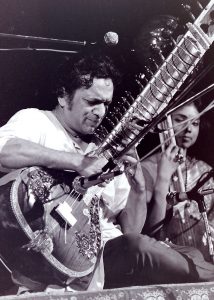
Ravi Shankar (1920-2012) Is a classical Indian sitar player and the most important musician to bring Indian classical music into western popular music. Though Shankar himself was primarily a classical musician, his friendship with George Harrison and his appearance at the 1967 Monterey Pop Festival brought popularity to the genre. He taught sitar to George Harrison who incorporated the instrument into his songs. Many other musicians followed suit including the Byrds and the Rolling Stones. Many western musicians continue to incorporate Indian classical music into popular songs.
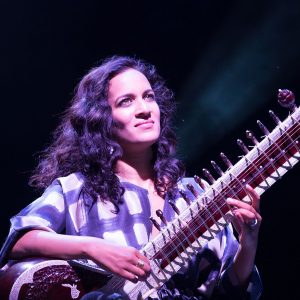
Anoushka Shankar (Born 1981) is a virtuoso sitar player and the daughter Ravi. Her music is a blend of different styles, classical, folk, and popular. Her music remains rooted in Indian classical music, but she has incorporated western classical, jazz, flamenco (Spanish folk music), electronic, and other genres. She has also performed with her half sister, singer/songwriter Norah Jones.
Listening Examples 25.5
Ravi Shankar at Monterey Pop Festival 1967 (Excerpt)


